The rowing machine is one of the best cardio machines in the gym for losing weight and getting in shape. Here’s how to master proper form and technique, plus some classic mistakes commonly made when rowing.
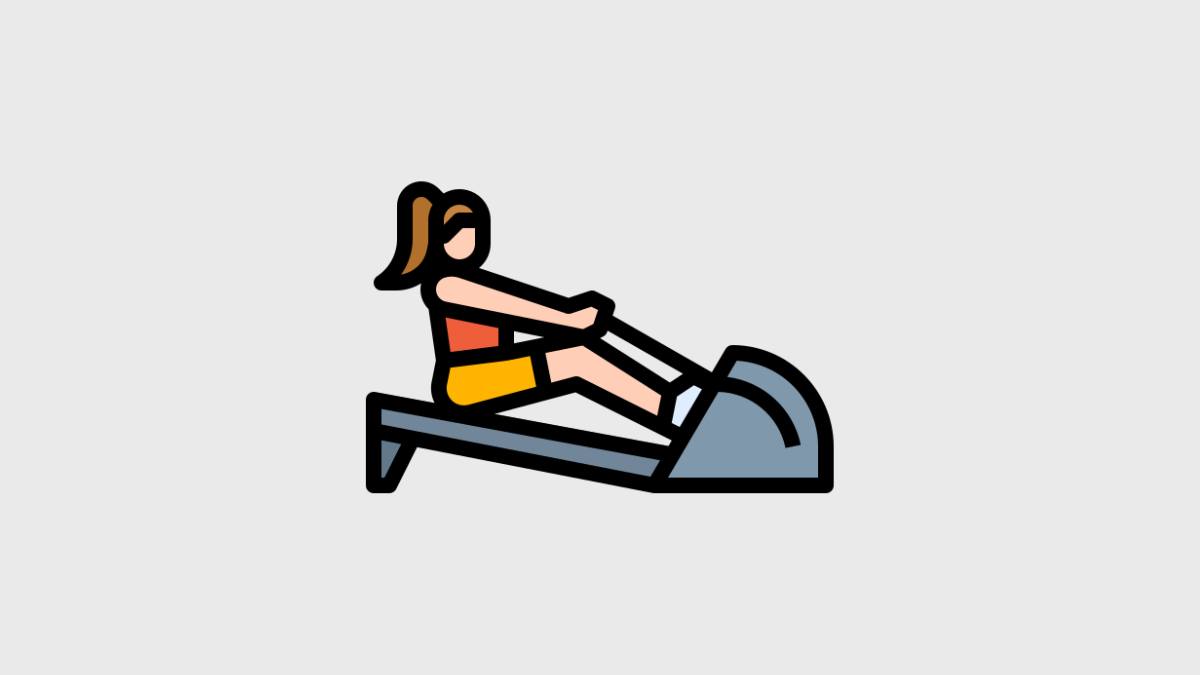
One very important thing I try to highlight to everyone I talk to about fitness or training is the importance of the proper form.
Correct form is crucial in both weighted resistance training and cardio training, but for very different reasons.
With heavy-weighted resistance training, incorrect form can lead to higher risk of acute injuries, as well as uneven muscle development.
But with cardio training, you’re repeating the same movement over and over again hundreds or even thousands of times. Over that many repetitions, even minor flaws in your form can lead to chronic or over-use injuries.
That’s why I preach the value of proper form no matter what exercise you’re doing!
In this article, we’re going to talk about how to have the right form when on the rowing machine.
It doesn’t matter if you’re doing a row machine HIIT workout, mixing up rowing and resistance training, or going for a low-and-slow hour-long workout—any workout you do, you have to have the right form in order to prevent injuries!
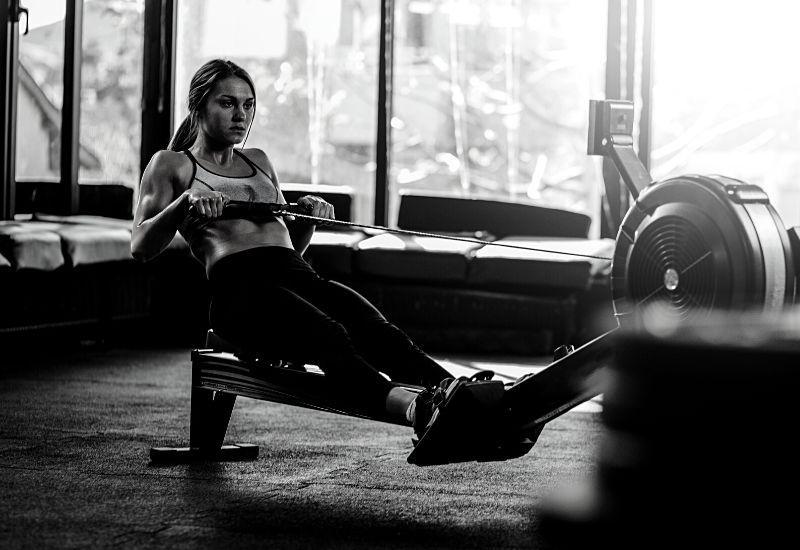
Why the Rowing Machine Rocks Our Socks Off
Before we dive into the proper form, I want to take a moment to highlight the benefits of rowing machines specifically as it pertains to your fitness efforts.
There are a lot of reasons to use the rowing machine—and use it correctly by learning the right form:
? Full-Body Workout
If you look at the list of muscles worked on the rowing machine, you’ll see that the machine delivers a nearly full-body workout.
Every time you row, you work your:
- Upper back
- Shoulders
- Biceps
- Forearms
- Abs
- Lower back
- Hamstrings
- Glutes
- Quads
- Calves
That’s a lot of muscles engaged in just this one movement!
Instead of focusing on just your lower body (like so many other cardio machines do), the rowing machine will get your upper body and core working, too, which will be game-changing for developing your overall fitness.
? Great for Weight Loss
The rowing machine is one of my favorite cardio machines for weight loss, hands-down.
There are A LOT of calories burned on the rowing machine—according to Harvard Medical School, a big guy of my size (~200 pounds) can burn upwards of 300 calories in a 30-minute moderate rowing session, or 450+ in a 30-minute vigorous rowing session.
Now that’s results!
What’s great about the rowing machine for weight loss is that it engages a lot of muscles (as you saw above), so it forces your body to not only burn calories for energy to expend while training, but also to replenish the depleted muscular energy stores after training.
You’ll keep burning calories for an hour or so after the workout is done because your body is working hard to “refuel” your muscles. The more muscles you work, the more energy your body has to mobilize (from your fat stores).
The end result: better fat burning!
? Compatible with All Fitness Levels
Whether you’re totally new to the gym or an expert, the rowing machine will be a great choice for you!
For advanced trainees, there are all sorts of awesome ways you can make your rowing machine workout more challenging—EMOM sprints, mixing up bodyweight training and rowing, ladder rowing, Tabata cycles, HIIT, and the list goes on.
But even for those who have never learned how to use a rowing machine, the machine is fairly simple to master. Really, you just have to learn the correct form (which we’ll explain in the next section), and you can start rowing efficiently from Day One.
There are so many options for rower machine workouts for beginners, too, helping you to start pushing your fitness to the next level no matter how inexperienced you are.
All pretty great reasons to love the rowing machine, right?
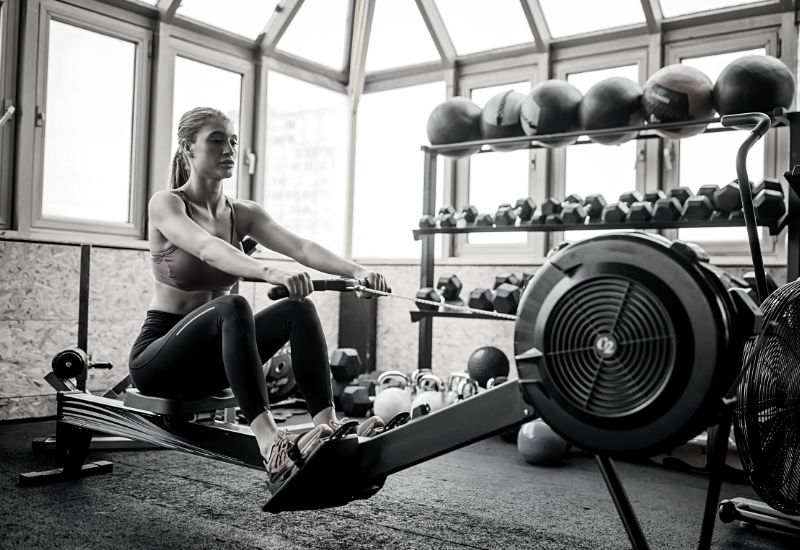
Tips for Proper Form on the Rowing Machine
If you’re going to get on the rowing machine, it’s important that you learn the correct posture and form in order to move correctly.
Otherwise, you’re more prone to injuries (both acute and chronic due to overuse) that could impair your training.
Below, I’ll walk you through the correct technique for using the rowing machine.
It’s broken down into four basic parts:
The Catch
This is both the “setup” and the “end” of the rowing stroke.
- Sit with your back straight and head up, leaning slightly forward at the hips to an 11 o’clock position.
- Your arms should be fully extended but your elbows slightly bent—NEVER lock out your elbows!
- Keep your shoulders level and relaxed, never hunched.
- Your shins should be perpendicular to the floor, as close to “vertical” as possible.
- Allow your heels to lift up from the pedals if needed.
From this position, you’re ready to move into the Drive.
The Drive
This is the “work” part of the rowing stroke, when your lower body pushes and your upper body pulls.
- Drive first with your legs, pressing your heels into the pedals and extending your legs.
- As your legs straighten, hinge backward at the torso moving toward fully vertical.
- Only once your legs are nearly straight should you begin pulling with your arms.
- Keep your hands moving in a straight line from the flywheel to your belly—do not raise or lower them above the “flat” level.
- Keep your shoulders relaxed and let your arms and back do the work of pulling.
The Finish
Now you’re “finishing” the backward part of the stroke.
- End with your upper body at roughly 1 o’clock position (a slight backward lean).
- Your legs should be fully extended but your knees remain unlocked.
- The handle should be touching your belly just below the level of your ribs.
- Your wrists should be flat, your grip on the handle relaxed.
- Your shoulders should remain relaxed, never allow them to hunch or round.
The Recovery (or Return)
Now it’s time for the “recovery”, when you return to the start position doing the original movement all in reverse.
- Start by extending your arms, keeping the handle on a “flat” level without allowing it to rise or dip.
- Begin to lean forward as you extend your arms, moving your body from the 1 o’clock position toward vertical.
- Once your arms are extended past your knees, bend your knees and slide the seat forward on the rail.
- Slide forward until your shins are once more vertical to the floor, your upper body is at a 11 o’clock position, and your arms are fully extended.
You’re now ready to start the rowing stroke all over again!
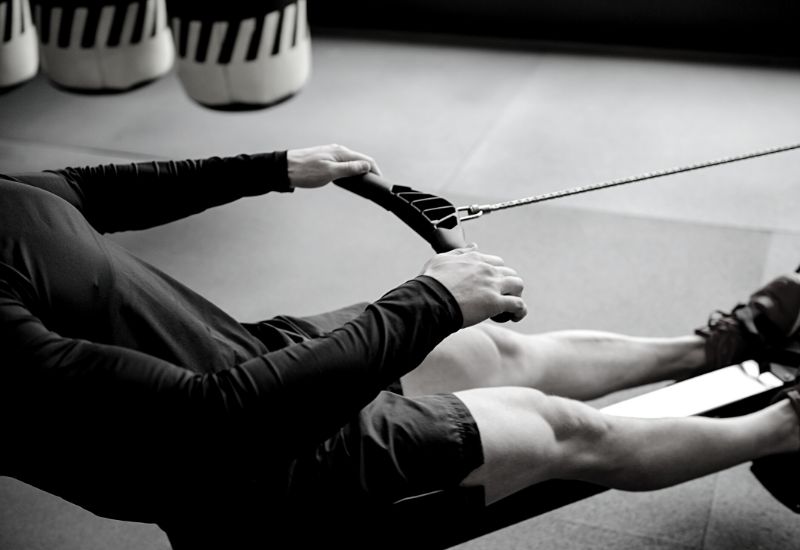
Technique Mistakes People Make on the Rowing Machine
The rowing machine is definitely one of the easiest of the gym cardio machines to master, with a form that you can learn fairly quickly.
However, just because it’s easy, that doesn’t mean people don’t still make mistakes. On the contrary, in fact—some people get so accustomed to a certain way of rowing that they fail to realize they’re even making a mistake that could A) compromise the efficiency of their workout, and B) lead to higher injury risk.
Here are the three most common technique mistakes people make on the rowing machine, their risks, and what you can do to correct and avoid them:
❌ Technique Mistake #1: Moving Your Upper Body Too Much
There is a real temptation to let your upper body do a lot of the work, because you may think that’ll help you increase your rowing stroke speed or pull harder.
Well, this can be a big mistake with big consequences for your lower back.
If you lean too far back during the Finish, your core will have to engage to keep your upper body from falling backward, which will actually take a lot of power away from the actual stroke.
Plus, just like with sit-ups, there is a risk of lower back strain with this repeated engagement of the core muscles.
Another upper body technique mistake is collapsing your chest too far forward during the Catch. This is usually your body’s way of trying to speed up by extending your arms back toward the “start position” more quickly.
The problem is, this will A) compromise your ability to breathe properly, which will lead to fatigue; and B) increase your risk of lower back and shoulder strain. The collapsing of your chest forces your lower back and shoulder muscles to engage incorrectly.
Keeping your chest up and restricting your body to just the correct range of motion—11 o’clock to 1 o’clock—is crucial for maximizing performance while minimizing risk.
❌ Technique Mistake #2: Incorrect Arm Movement
Your arms do only some of the work; in truth, it’s your legs that should be pushing through the drive, with your arms only coming in at the end.
If you begin to pull with your arms too early in the stroke, you’ll reach the Finish and have very little power. You’ll also tire your arms out unnecessarily, increase the risk of back and shoulder injury, and reduce leg muscle engagement.
Make sure that your legs are almost fully extended before you bring your arms into the mix. That way, you’ve already driven hard with your lower body 60% of the way, and the rest is divided evenly between your core and arms.
Also, when returning to your starting position in the Recovery phase, make sure that your arms are nearly fully extended before you bend your knees.
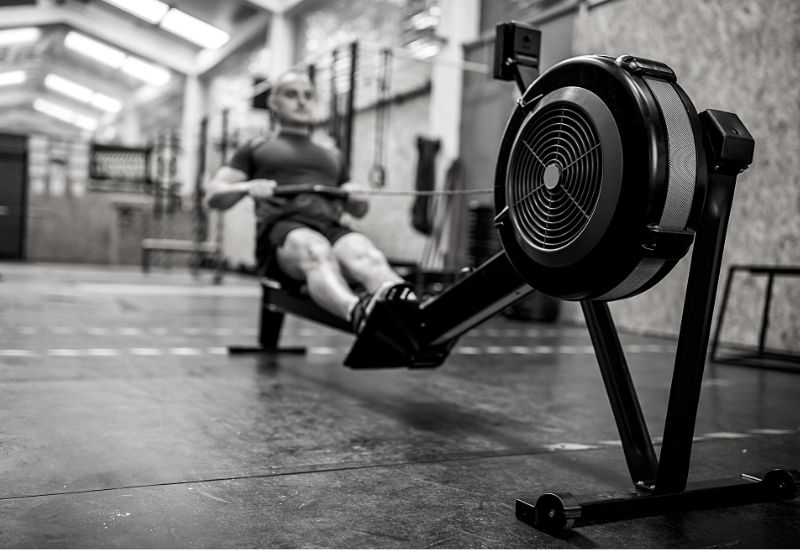
One very common mistake newbies make is bending their knees too soon, which forces them to lift the handle to get it over their knees. This will slow down your stroke and reduce efficiency.
The key is to bend slightly forward at the waist while extending your arms, then bend your knees at the end to bring you sliding forward to the Catch.
Done right with both the Drive and Recovery, you’ll have a much more efficient rowing form.
❌ Technique Mistake #3: Leading With Your Butt
This is one mistake you will definitely regret!
Some athletes, thinking they can gain more power during the drive, will sort of shoot their butts out backward before straightening their legs. This isn’t a “secret technique” or “sneaky hack”, but a mistake that can compromise your form and increase your risk of injury.
You see, when you shoot your butt backward, you’re placing greater emphasis on the lower back, specifically the spinal muscles around and above your pelvis. These muscles are the ones most prone to injury, which is why this movement can be so dangerous. You’re risking lower back problems by shooting your butt out.
Instead, keep your butt firmly planted on the seat, and focus on driving through your legs. Let your quads do the majority of the work—they’re the largest lower body muscle group, and can generate the most power.
The Bottom Line
The rowing machine is an absolute game-changer for your fitness, a cardio machine that can build both muscular and cardiovascular endurance efficiently if used right.
Learning the proper form is crucial for not only a more effective workout, but also smart prevention of injuries.
The tips above will help you master the basics, and you can put them into practice starting TODAY to become a better rower.
Over time, you’ll find that rowing with the proper form will do wonders to keep you safe while also yielding better fitness results.
Now that’s what I call a win-win!
More Articles Like This
The Best Cardio Workouts to Do at the Gym (Plus Benefits, Machines, and Sample Workouts). Ready to take your cardio game to the next level? Here’s a look at some killer cardio workouts to use the next time you hit the cardio room.